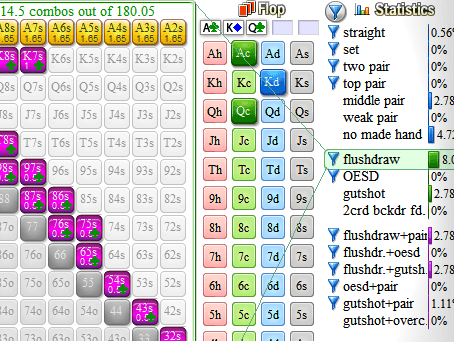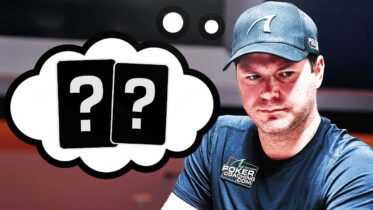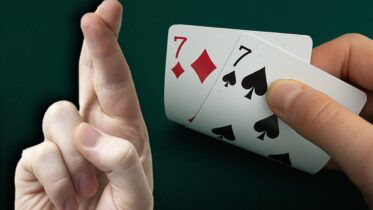Today let’s discuss simple tricks that we can use to help improve your ability to put your opponent on a range of hands. This is one of the most important skills of a high-level poker player. They are able to quickly assess the strength of a player’s range and react in the proper way. In this article, I will teach you how to: 1) Quickly identify the strongest hands in the opponent’s range 2) Use suited and offsuit combos to determine the amount of two pair combos in the opponent’s range 3) Identify how combinations change when facing UTG compared to Button ranges.
Identifying the Strongest Hands
This should be the first thing we do after the flop comes. Let’s say our opponent raised UTG and the flop comes Ks-Ts-2h.
Step 1
Count the combos of straights and flushes our opponent has. Here, that is not applicable since no straights or flushes are available.
Step 2
Recognize the sets in our opponent’s range.
From UTG we could assume our opponent has all combos of KK and TT but we are unsure of 22. It could be all combos of 22 (3), no combos (when he open folds 22 preflop), or somewhere in between (when he mixes 22 preflop). This particular opponent is tight, so we can assume he has 0 combos of 22. Next, we can learn how to use suited vs unsuited hands to identify his two pair combos.
Utilizing Suited and Unsuited Combos
Our villain raised UTG, so we can assume he opens all SUITED broadways combos, but none of the marginal offsuit broadways. On Ks-Ts-2h, the only two pair combinations available since he only has suited combos is KTs. With the K and T spades on the board, that leaves 3 combos of KTs in his range. Remember there are 16 ways to make KT, 4 suited and 12 offsuit.
Let’s assume we are in the BB and hold KdJc. Since we have the Kd in our hand, we can remove another combo of two pair from his range. Now he only has 2 combos of KTs. Since the opponent raised UTG, we know he can never have K2s, T2s, as well as their offsuit versions. So now we know our opponent has a couple combos of KTs and a few sets in his range.
How Hand Ranges Change on the Same Board
UTG compared to the Button.
Next, I want to show you how the combos change when our opponent is the button instead of UTG. We will use the same Ks-Ts-2d board. Now, our opponent has all sets and many more 2 pair combos. Now our opponent is raising KTo and K2s pre-flop. How many combos of KTo does our opponent have?
There are 3 remaining Kings in the deck and 3 remaining Ts. Thus, 3×3 = 9 combos of KTo. Now for example let’s say we still have KJ in the big blind. Now there are only 2 remaining Ks and 3 Ts. So, our opponent has 3×2 = 6 combos of KT in his range. Without the King in our hand and 9 available combos of KT to go along w 2 more combos of K2s, we can see now our opponent has 11 combos of 2 pair compared to the 3 combos he had UTG.
The key thing here is that there are more 2 pair combos available to late position players than early position players because more offsuit cards are played. This rules also applies to tight players compared to loose players. Loose players have many more combinations of 2 pair available to them because they play more offsuit hands than tight players.
3 Simple Steps
Use these 3 simple steps to help start to develop your hand ranging skills. Identifying the top ends of your opponent’s range is key to making decisions. Learn to recognize that UTG can only have 4 combos of straights on JT7 compared to the button who can have all 16 combos of that straight. Learning to identify the top end of the opponent’s range is key to knowing when you can apply a lot of pressure and when you can’t.
Take action in your next session. On every flop, turn, and river, identify how many combos of nuts or very strong hands your opponent can have. Practice this exercise while not in your hands so you are more comfortable when doing it in real time. Learn how to adjust the ranges when the player is UTG or on the Button, or in the Big Blind. Learn how to make assumptions you can trust about a poker player’s opening range. Also, take action in using the cards in your hand (or that you folded when observing) to help range the opponents more accurately.
Best of luck!



